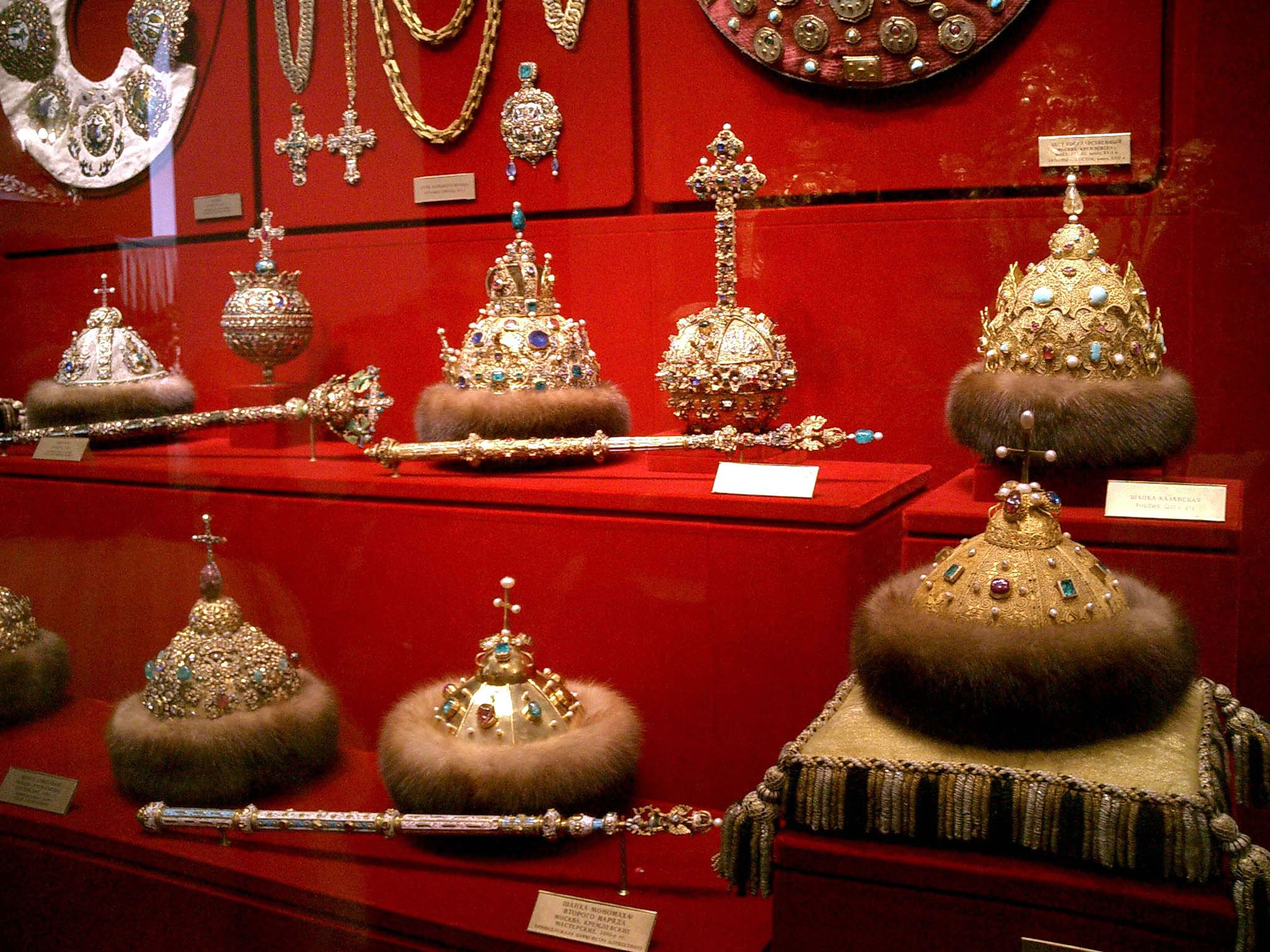

La prima corona dei Gran Principi di Mosca fu quella cosiddetta "di Monomaco", che era appartenuta ai Gran Principi di Kiev, di cui quelli della Moscovia erano discendenti, e che secondo la leggenda era stata donata dall'imperatore bizantino Costantino IX Monomaco al nipote Vladimir, fondatore dell'omonima città e antenato patrilineare di Ivan III. La leggenda servì quindi quale fondamento per la teoria politica di "Mosca come la Terza Roma". Conseguentemente il copricapo venne ricordato come la corona di Monomaco, denominazione rintracciata per la prima volta in un documento russo del 1518. Dopo che Ivan il Terribile si auto-incoronò primo zar di Russia con la corona, il re di Polonia gli chiese di spiegargli il significato del suo nuovo titolo; alla domanda, Ivan rispose che chiunque fosse incoronato con la corona di Monomaco è tradizionalmente chiamato zar, perché essa era un dono di uno zar (cioè Costantino IX), il quale aveva spedito il metropolita di Efeso a Kiev per incoronare Vladimir Monomaco con questa corona. La risposta di Ivan fu probabilmente una beffa deliberata, perché all'epoca della morte di Costantino IX Monomaco, Vladimir Monomaco aveva solo due anni e non era ancora il sovrano kievano.
Nel 1721 Pietro il Grande adottò il titolo occidentale di imperatore e, in questa occasione, sostituì la corona di Monomaco con la corona imperiale di Russia.
All regalia of Imperial and Tzar's Russia that are kept in The Diamond Fund, Kremlin, Moscow

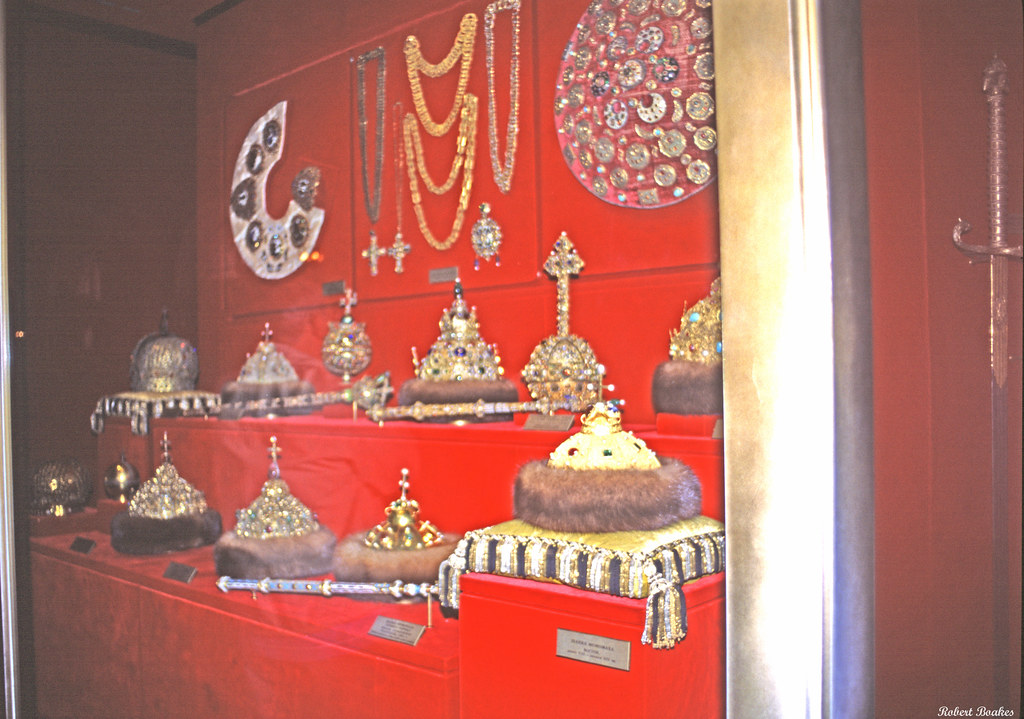
Monomakh's Cap (Russian: шапка Мономаха, shapka Monomakha), also called the Golden Cap (Shapka Zolotaya), is a chief relic of the Russian Grand Princes and Tsars. It is a symbol-crown of the Russian autocracy, and is the oldest of the crowns currently exhibited at the Kremlin Armoury. Monomakh's Cap is an early 14th-century gold filigree skullcap composed of eight sectors, elaborately ornamented with a scrolled gold overlay, inlaid with precious stones (ruby and emerald) and pearls, and trimmed with sable. The cap is surmounted by a simple gold cross with pearls at each of the extremities.

Ivan IV Il Terribile conquistò il Khanato di Kazan e si fece incoronare con la corona del Khan di Kazan, che da quel momento divenne parte del tesoro della corona di Mosca.
Kazan Crown of Ivan IV
Ivan il Terribile conquistò successivamente anche il Khanato di Astrakhan e si appropriò della sua corona.
La Corona di Astrakhan fu successivamente impreziosita e unita allo scettro e al globo per ordine di da Michele Romanov, fondatore della dinastia imperiale russa, che le considerò come insegne ufficiali dello zar.

Astrakhan (Venice "Great outfit" golden cap of the first dress, fryaskaya). It was made in 1627 for Mikhail Fedorovich in order Yefim Telepneva duma.


La corona di Altabas simboleggiava il dominio sulla Siberia.
Altabas Crown. (Siberian). In 1684. The fabric, brocade, gold, precious stones, pearls, fur, casting, chasing, carving, enamels. Armory. Moscow. Belonged to Tsar Ivan Alekseevich. The work of the Moscow Kremlin Workshops

Alla morte dello zar Alessio Romanov, gli succedettero come co-eredi Ivan V (affetto da demenza precoce) e Pietro I (che all'epoca aveva solo sei anni, ma che era destinato a diventare "il Grande").
Ivan V fu incoronato con una corona di gioielli e diamanti, mentre Pietro fu incoronato con una nuova versione minore e sobria della corona di Monomaco.
Ivan V diamond crown One of the two crowns made in 80-s of the XVIIth century by Kremlin jewelers for Tsar Ivan Alekseevich and his brother-in-law Peter.

The Monomakh Crown of the Second Order was made for the dual coronation of child Peter Alexeevich.

Essendo Ivan V demente e Pietro I infante, per dieci anni la reggenza fu esercitata dalla sorella maggiore Sofia Aleksievna.
Nel 1689, quando finalmente Pietro riuscì a deporre Sofia e a mandarla in convento, si fece realizzare una nuova corona, nota come la corona di diamanti di Pietro il Grande.
The Diamond Crown of Czar Peter the Great, Russia (1680's; gold, silver, precious gemstones, pearls, fur).


Cap of Monomach 1 - Cap of Monomach II - Cap of Kazan and Crown of tsar Mihail Romanov

Gli zar di Russia erano anche re di Finlandia
The design of the never used Crown of Finland.

Dopo la morte di Pietro il Grande si ebbe un periodo di "torbidi" con una lotta interna alla dinastia.
Inizialmente prevalse la zarina Anna Ivanovna, figlia di Ivan V, che si fece costruire una corona di foggia bizantina.
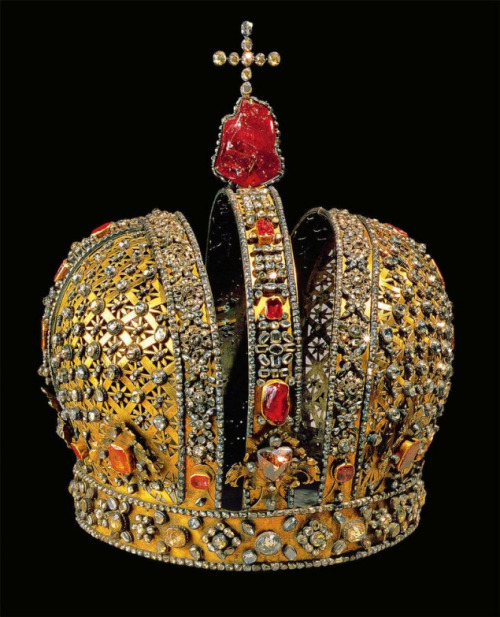
Ma la vera Corona Imperiale di Russia ("di tutte le Russie") fu realizzata per l'incoronazione di Caterina II, vedova di Pietro III, nipote di Pietro I.
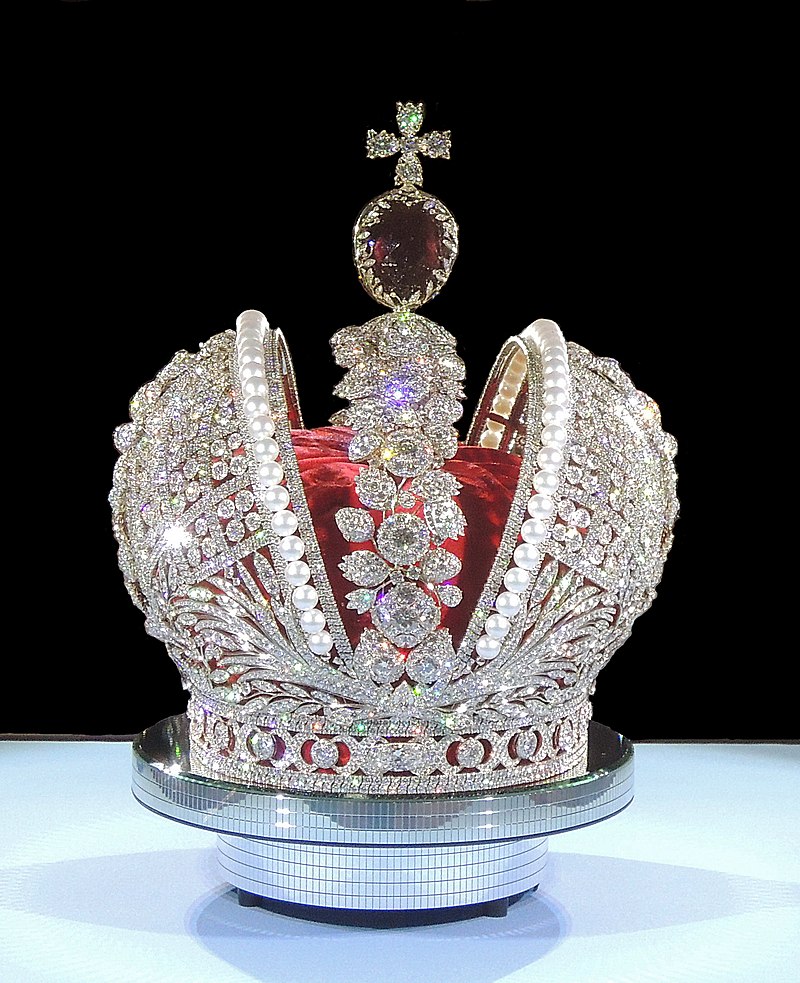
http://www.wikiwand.com/en/Regalia_of_the_Russian_tsars
Oldest Russian regalia
- Barmas of Old Ryazan, One of the greatest masterpieces of ancient jewelry were produced by masters of Old Ryazan in late 12th - early 13th century. They belonged to the local prince's family, but in 1237 the city was completely destroyed by Batu Khan, and the jewelry lay underground for nearly 600 years. In 1822, the royal barmas were found by archeologists and brought to the Armory. These precious barmas are proof of the high level of local jewelry, enameled with their precious stones, gold medallions decorated with engraving. Medallions on one of the sets have a picture: The Crucifixion with the Virgin and John the Baptist, Virgin, Martyr Irene and Barbara, in royal attire Saints and others of the medallion has a Greek inscription, it is likely these parts have Byzantine origins.
- "Cap of Monomakh" The oldest crown is the "Cap of Monomakh" or Crown of Monomakh, used in the ceremony of crowning a monarch in Russia. Its name is connected with a Russian legend of the 15th century, according to which it has been brought to Russia in ancient times as a gift from the Byzantine Emperor Constantine Monomachos. The cap is of oriental workmanship of the late 13th or early 14th century. The question of its origin is still unspecified. The oldest section of the crown consists of eight gold plates adorned with very fine gold lace in a pattern of six-pointed rosette-stars and lotus blossoms. The semi-spherical top with a cross, the sable trimming and the pearls and gemstones belong to a later period. It weighs 698 grams and is the lightest Russian crown. Since the late 14th till the late 17th century, the Cap of Monomakh a symbol of power, was used in the ceremony of setting the ruler of the Russian State for reigning. In the first quarter of the 18th century, after Peter the Great's reforms, the ceremonial setting for reigning was replaced by coronation, the main attribute of which became imperial crown. Since 18th century the Cap of Monomakh served as heraldic crown of the "Tsardom of Great, Little and White Russia".
Main article: Monomakh's Cap
|
Two oldest Russian crowns - "Cap of Monomakh" and Kazan Crown.
- Kazan crown The Crown of Kazan belonged to Ediger Mahmet, the last ruler of the Tatar (Tartar) state of Kazan. This 16th century crown is the second oldest in Russia. The gold crown is studded with pearls, garnets, and turquoises. The sable-fur trimming was for comfort. The Kazan Crown is dated by 1553. It was first mentioned in the treasury of Tsar Ivan the Terrible, whose reigning was signed by a series of eminent events in the Russian history. Among them is the capture of Kazan in October 1552 and annexation of the Kazan khanate to the Russian state. The precious crown might have been executed by Moscow Kremlin jewelers on the successful solution of "The Eastern problem", so important for Muscovy. Its name might have immortalized the memory of the glorious victory of Russian warriors. The crown's look combines national and eastern artistic traditions. Some elements remind decor traditions of Russian churches of the epoch. At the same time, combination of stones, e.g. red tourmalines and rubies with blue turquoise and carved ornament of knitting herbs on niello background represent oriental artistic influence. Since 18th century this crown served as heraldic crown of the "Tsardom of Kazan".
- Ivory throne This is earliest survived tsars throne of the mid-16th century. This fine specimen of Renaissanceculture was made of wood faced with plates of ivory and walrus tusk therefore it was called the "carved bone armchair". The carved ornament unites the various subjects and representations into a single composition. Decorative scenes include images from Greek mythology and the Old Testament. The depicted themes, the style of the carving and the motifs, which include grotesques and Cupids, enable researches to date most of the pieces to the 16th century and attribute them to Western European Renaissance craftsmen. This bone throne has been renovated several times in Russia: worn pieces of bone were remade by local craftsmen; in 1856, on the occasion of the coronation of Emperor Alexander II, the throne was decorated with a gilded silver two-headed eagle.
Regalia of Boris Godunov
- Golden throne In addition to the bone chair the showcase includes a throne of oriental workmanship executed in the late 16th century. Having been presented by Shah Abbas I to Tsar Boris Godunov it was called a "Persian throne with stones". The form of the throne with its low back flowing into sloping arm-rests, reveals features typical of Iranian furniture of the 16th-17th centuries. The makers have used ornament beloved in the East, i.e. strips of gold decorated with a foliate pattern and coloured stones - blue turquoisesand red rubies, tourmalines. The back of the seat, the arms and the whole lower section of the throne were covered with gold Persian fabric, replaced by French velvet in 1742 for the coronation of Empress Elizabeth. In total this throne is adorned 552 rubies and pink tourmalines, 825 turquoises, 177 pearls and 700 halves of pearls.
Scepter and orb are magnificent creations of West-European jewelry of Late Renaissance. By the way, the enamels on relief technique was not known to Russian goldsmiths of that time. There are reasons to consider the scepter and orb to belong to the set of gifts, brought to Tsar Boris Godunov in 1604 by the Great Embassy of Rudolf II, Emperor of the Great Roman Empire. The scepter and orb, miraculously survived through the Time of Troubles, must have been used in 1613 in crowning of Michael Fyodorovich, first Tsar of the Romanov Dynasty. For later on during the whole reigning of Michael Fyodorovich they were unique regalia of the kind and belonged to the so-called "Grand set" (precious tsars attire) complex of especially valuable regalia. Later "Grand set", which, except for the state regalia, included an armour set, that accompanied the Tsar in processions, e.g. military companies and hunting.
- The sceptre The golden scepter is graceful and proportional, with rich and dainty ornamental motifs. The heads of cherubs, flowers and clusters of fruits suspended on ribbons – everything belongs to a unique, rhythmically sized composition. This ancient sceptre has 1 emerald, 20 diamonds and a few other precious stones.
- The orb Huge golden orb is crowned with a cross. In the upper hemisphere girdles separate it into four sections each with an Old Testament scene from King David's life: "Chrosmation of King David by Prophet Samuel", "David's mastering Goliath", "Coming home with the victory", "Persecution from Saul". Shining gems, green emeralds, red rubies, and blue sapphires, encircle the enamel ornamentation. The Orb has 58 diamonds, 89 rubies and tourmalines, 23 sapphires, 51 emeralds and 37 pearls. Except for the 4 enamels, the entire orb, including the cross, is thoroughly encrusted with the various gems.
Regalia of Michael Fyodorovich
The crown of "Grand set" - "Astrahan crown"
- Golden carving chain This chain was presented to Tsar Michael Fyodorovich in 1631 by the Dutch. It was made in Western Europe in 1620s, later in Russia it was altered and became part of the "Grand set". It consists of 79 carving blackening rectangular links.
- Golden chain The golden chain belonged to Tsar Michael Fyodorovich. It was executed by Kremlin makers and first mentioned in papers of the State treasury in 1640. It consists of 89 rounds, slightly convoluted rings with an ornamental inscription on each ring. The inscription includes a praying to the Holy Trinity, the complete title of the Tsar with a list of towns, princedoms and lands of the Russian State and the Tsar's hortation to live according to the precepts of God.
- The crown The crown of "Grand set" belonged to Tsar Michael Fyodorovich. It was executed by Kremlin master E.Telepnev in 1627. Crown has 177 precious stones and pearls. Since 18th century this crown served as heraldic crown of "Tsardom of Astrahan".
"Grand set": the crown of Michael Fyodorovich with orb and sceptre of Boris Godunov.
- Golden throne The throne of Tsar Mikhail Fyodorovich was executed at the beginning of the 17th century from the old chair of oriental workmanship which had belonged to Ivan the Terrible. In its form, high back and arms, it resembles Russian armchairs, but oriental motifs still remain in the ornament:[1] The throne is faced with embossed gold and adorned with rubies, pearls, turquoise and other uncut stones. The throne was made in the early 17th century in Kremlin Workshops. Its decoration is similar to that of the throne of Boris Godunov. 13 kilos of gold, gemstones and pearls were used for its ornamentation. Partly throne's decoration haven’t survived. A part of golden plates in the base as well as the throne's pediment were missing. In total on this throne are surviving 1325 rubies and tourmalines, 559 turquoises, 16 pearls, 28 sapphires and 36 other precious stones.
Also "Grand set" consist from various precious armament and equipment, survived in Kremlin Armoury. Most important from these things are:
- Saadak and quiver Saadak (precious bow-case) of "Grand set", in complect with quiver, was executed in Kremlin c.1627:[2] In total saadak and quiver are adorned 183 diamonds, 5 rubies, 34 sapphires, 153 emeralds and 139 tourmalins.
- Shield This precious steel (with carving gold designs) shield was made by master Muchammed Mumin Zernishan in Persia in late of the 16th century:[3] Until 1620 it belonged to prince Fyodor Mstislavsky (former Semiboyarzchina Head), after his death it was taken to Kremlin Armoury and became part of "Grand set". It is adorned 1478 small gemstones and 32 pearls.
- Sabre Sabre of "Grand set" was made by Kremlin masters in 1620-s. It very rare artefact has 552 diamonds and 165 other precious stones, mostly pink tourmalins.
- "State helmet" This helmet - "ericho cap" - was made in Turkey in 1600-s, and altered in 1621 in Kremlin Armoury by masters N.Davydov and I.Markov, and later in 1642. Steel helmet with golden carving, it has Turkish inscription - quotations from Qur'an. It is adorned 116 diamonds, 10 emeralds, 225 tourmalines and 164 pearls. By latest legend, this regalia belonged to Saint Alexander Nevsky. Since 18th century it served also as heraldic Helmet of Russian Empire.
"State helmet" on picture of 19th century
Broadsword of Tsar Michael Fyodorovich on picture, 19th century.
After Tsar Mikhail Fyodorovich death in Kremlin Armoury were given his personal jewels and equipment, not applied to "Grand set". Most important from them are:
- Broadsword Broadsword was executed by master Czech Nil Prosvit in Kremlin Armoury in 1617. It has inscription: «Sy tesak sdeelan poweleniem Gossudara Tzaira i welikoвo Knesa Michaila Feodorowitcha vsea Rrusyi v paetoie leeto gossudarstwa ieвo, maesetza... Po prikasu kraitscheвo y oruschnitscheвo Michaila Michai-lowitscha Saltikowa; deelal master Nial Proswit».
- Sabre Sabre of prince Fyodor Mstislavsky after his death in 1620 was taken to tsars treasury. It is made in Turkey in 16th century and has Arabian inscriptions.
- Helmet Unique precious helmet of prince Fyodor Mstislavsky, is made of damascene steel and gold in Ottoman Empire in the 16th century:[4] In 1620 it was taken to tsar's treasury. Helmet is adorned rubies and turquoisesand has quotations from Koran.
- ericho cap "Ericho cap" of prince Fyodor Mstislavsky. Ottoman Empire, 1600-s.
- ericho cap "Ericho cap" of prince A.M. Lvov. Made in Ottoman Empire probably in 1610-s - 1620-s.
Regalia of Alexis Mikhailovich
New Tsar Alexis Mikhailovich ordered his regalia mostly in Turkey and Persia in 1650-s - 1660-s. His "Grand Set" consists of:
- The sceptre Sceptre was executed in Istanbul in 1658 and presented to the Tsar by a Greek Ivan Anastasov:[5] This oriental sceptre has mace form. It has 268 diamonds, 14 emeralds, 360 other precious stones. Golden handle has 12 small carved medallions this pictures of great Christian holidays: The Annunciation, The Ascension of Jesus, Christmas Day, Feast of the Presentation of Jesus at the Temple, Epiphany, Raising of Lazarus, The Transfiguration of Jesus, Palm Sunday, The Crucifixion of Jesus, Resurrection of Jesus, Pentecost, Assuring of St Thomas.
- The orb In archives there are records the orb with already mentioned barmas were brought to Tsar Alexis Mikhailovich by a Greek Istanbul citizen, Ivan Yuriev in 1662:[6] It has 179 diamonds and 340 other precious stones.
- Barmas Barmas of Alexis Mikhailovich executed in Istanbulon his order in 1662. It is a round silk collar, adorned with seven precious medallions. The centre of medallions are round golden plates with religious compositions of colour enamels. Three large medallions are of particular interest. Two of them are not plane, like all the others, but a little bossy. They were to cover shoulders. The shape of the third medallion is a bit different, so it can be considered a central one. It is adorned with a scene of Our Lady sitting with a Baby in her lap, crowned by two angels. One shoulder medallion includes a cross confronted by Saints – Byzantine Emperor Constantine and his mother Helen, who were famous devotees of Christianity. Another shoulder medallion presented Basil the Great and Saint Warrior Mercury, piking Emperor Julian, enemy of Christians. A legend says he was killed by Saint Mercury, who pretended to be an enemy warrior. The precious holy of the 17th century may have hinted the role of the royal power in the Christian world and the mission of the very Russian Tsar. In total all 7 precious medallions have 248 diamonds and 255 other precious stones.
Also a private treasury of Alexis Mikhailovich consisted of:
Diamond throne of Tsar Alexis Mikhailovich, in Kremlin Armoury.
- Diamond throne The shape of the so-called "diamond armchair" of Tsar Alexei Mikhailovich, the most elaborate of the Royal thrones in the Armoury collection, is reminiscent of the throne of Tsar Mikhail, his father. The throne was made by Persian makers in 1659 and granted to the Tsar by merchants Ichto Modovletov and Zakharia Saradarov from the Armenian Trading Company in 1660. The throne has been made of sandalwood faced with golden and silver plates with foliate ornamentation. Its bottom is decorated with a bold carved pattern depicting a procession of elephants and drivers on their backs. The back of the throne is covered with black velvet and embroidered images of two genii supporting a crown over the inscription glorifying the Tsar and his power. The whole surface of the throne is faced with an intricate mosaic of turquoise and diamonds. The precious donation was attached to the petition of tax-free trading in the Russian territory. The Armenian merchants got 4000 silver rubles and 19000 copper rubles for this throne. For the prevalence of diamonds the throne was named "Diamond Throne". In total throne has 876 diamonds and 1223 other gemstones. On the back of this throne there is an embroidered Latin inscription: "Potentissimo et invictissimo Moscovitarum Imperatori Alexio, in terris feliciter regnanti, hic thronus, summa arte et industria fabrefactus, sit futuri in coelis et perennis faustum felixque omen. Anno Domini, 1659" ("To the most powerful and invincible Muscovy Emperor Alexis doth reign felicitously upon the earth the throne made with sumptuous art would be a token of future eternal bliss in heaven. In the Year of Our Lord. 1659").
- The staff "His Majesty's staff":[7] This precious staff was executed in Istanbul in 1658 and presented to Tsar by a Greek Ivan Anastasov in 1662. It has a lily in top. In total this unique oriental staff has 178 diamonds, 259 emeralds, 3 pearls and 369 pink tourmalines.
- Plaque-pendant Precious plaque-pendant for tsars coronation clothes was executed in Istanbul in 1660-s.
Also, Tsar Alexis Mikhailovich had various personal military equipment of his own "Grand set". Now these artefacts are on display in Kremlin Armoury, most famous of them are:
- Saadak and quiver Precious saadak in complect with quiver was executed in Istanbul and presented to the Tsar by Greeks Ivan Yuriev and Dmitry Astafiev in 1656:[8] In total unique oriental saadak and quiver have 306 diamonds, 40 emeralds and 1256 tourmalines.
- Sabre Precious sabre was made in Istanbul and presented to the Tsar by Greek Ivan Bulgakov in 1656:[9]
- Helmet Helmet-"ericho cap" of "Grand set" was made in Turkey in 1600-s, until 1620 it belonged to prince Fyodor Mstislavsky and later - to Tsar Alexis Mikhailovich:[10] It has golden and silver designs and 61 pearls and gemstones.
- Concir State sword-concir in golden sheath was executed in Istanbul and presented to Tsar Alexei Mikhailovich by Greek Dmitry Astafiev in 1657. Concirs sheath is adorned by 63 tourmalins and 205 turquoises.
- Busdychan The mace-busdychan of "Grand set" was executed in Istanbul and presented to Tsar Alexei Mikhailovich by Greek Dmitry Astafiev in 1655. It has 46 emeralds and 109 pink tourmalines.
Tsars' regalia 1660s-1680s
- Pectoral cross with a chain This cross was executed by Kremlin masters in 1662 and altered in 1682. Only this regalia survived from "Grand set" of Theodore Alekseevich - elder son of Alexis Mikhailovich. It is golden cross with diamonds, with golden chain. On facial side of cross there is 4 enamelled medallions this pictures of: The Transfiguration of Jesus, The Crucifixion of Jesus, Last Supper and Entombment of Jesus. On the verso of the cross there is an image of a heaven protector of the Tsar - Theodore Stratilates. The figure of the Saint, floral pattern around it, as well as religious scenes on the obverse of the cross are executed in bright shining colours, which make all the compositions similar to a multicolour shining mosaics.
In 1682 Russia received two so-rulers - Ivan V Alekseevich and Peter I Alekseevich. Both of them had own jewels (but one throne).
- Silver double throne The Double throne of Tsars Ivan Alekseyevich and Peter Alekseyevich, which serves as a vivid illustration of the unique historical moment, when two tsarevitches were crowned together:[11] Tsar Alexis died leaving three sons. After the death of the eldest one, Theodore, fifteen-year-old Ivan should have inherited the throne, but he was feeble-minded and in poor health. So it was decided to crown the two brothers together, Ivan and ten-year-old Peter (the future Peter the Great). The double-seated throne was executed specially for the occasion by the Kremlin craftsmen in the 1680s. Its constriction including open-work arch on twisted columns, silver steps below and a high back with two silver pillars on each side resembles elegant architectural forms. The necessary instructions and advice were transmitted through a small orifice cut into the back of the throne and concealed by the velvet covering. The shape of the throne is finished with a lavish ornamentation. The openwork embossment, three-dimensional animal figures, carving and high relief, contrasting combination of silver and gilt are exemplificative of the Baroque style.
Old Believer Priest Nikita Pustosviat Disputing with Patriarch Joachim on Matters of Faith. Painting by Vasily Perov(1880). Behind - stand silver double throne.
- Cap of Monomach of second set Simple "cap of Monomakh of the second set" of Tsar Peter I Alekseevich was executed by Kremlin Workshops for the 1682 crowning ceremony, when two small sons of Alexis Mikhailovich – Ivan and Peter – were inaugurated as Tsars:[12] The creators did their best following the ancient original. It reminds an Eastern headdress and consists of 8 golden plates. The crown has a dome-shaped top with a cross. However, there is certain difference in artistic decoration of the two crowns. The surface of the ancient one is covered with a delicate filigree ornamentation. The golden plates of the new crown were left smooth. Cold shining metal with sharp symmetric decor makes impression of elegant severity, a bit mildened by bright and colourful precious stones. Since 18th centhury this crown served as heraldic crown of Tsardom of the Chersonnese Taurics.
- Altabas crown Altabas crown of the third set of Tsar Ivan V Alekseevich was executed by Russian masters in 1684. Altabas is a precious cloth, similar to brocade. So the crown was named altabas. It is the only tsars crown executed of cloth. For the crown would not lose the shape, it had an inner frame of smooth silver arches. The crown was adorned with golden plates enameled with bright colours and coloured with gems. Some of these plates were taken from the not survived Diamond Crown of Tsar Theodore Alekseevich. In total it has circa 100 gemstones and pearls. Since 18th century this crown served as heraldic crown of "Tsardom of Siberia".
Picture of altabas crown, c. 1835.
- Diamond crownThis crown was executed by Russian masters for Tsar Peter I Alekseevich in 1680-s:[13] A similar crown was made for his elder brother, crowned at the same time. The decor of the crown represents specific features of Russian jewelry of the late 17th century, a specific feature of which was active using of precious stones. Shining diamonds and gems always attracted attention of Russian goldsmiths, and that time they became the main point of jewelry artworks. The Crown of Peter Alekseevich was enriched with green emeralds and red tourmalines. In total metallic golden frame of crown is adorned 807 diamonds (in 32 designs) and 13 other gemstones.
- Diamond crown One of the two crowns was made in 1680-s by Russian jewelers for Ivan V Alekseevich:[14] The decor of the crown is traditional for Russian jewelry of the late 17th century, a special point of which was active use of luxurious precious stones. On the crown's top there is a precious crimson lal. This golden crown has circa 900 diamonds and a few other precious stones.
Young Russian Tsar with "Cap of Monomakh", sceptre of Alexis Mikhailovich and orb of Boris Godunov.
- Pectoral cross of Tsar Peter I Alekseevich The golden cross of Tsar Peter Alekseevich was made in Kremlin workshops in the 80-s of the 17th century. In the center of its obverse there is a small cross made of magnificent emeralds of different cutting and shape, adorned with openwork vegetation ornament and enamels. The shape and decor of the emerald cross allow to classify it as an artwork of West European silversmiths of the 16-17th centuries. A carved crucifix on one emerald and a carved inscription "NIKA" on another are of Russian origin and can be dated by the same time.On the cross's reverse there is a front enameled image of Apostle Peter, the Tsar's patron Saint. The enameled decor of the cross in combination with shining precious stones give major impression in accordance with the common tendencies of development of Russian art of the time. The bright artistic concept and brilliant craft make the item a true masterpiece of the 18th century jewelry.
- Sceptre of Tsar Peter I Alekseevich The sceptre belonging to Tsar Peter I was made of gold and adorned with colour enamels and precious stones. The hexahedral scepter divides into three with three bolsters and its lower part ends with a bolster with a figured knob. The sceptre's form and details are close to the sceptre of Tsar Michael Fyodorovich of the 17th century. The decor reflects artistic taste of the late 17th century. Black and pink enamels on blue background, vegetation ornament of miniature graceful tulips, leaves and curls – all these have analogies in artworks by Kremlin jewelers of the 80-90-s of the 17th century. The sceptre must have been executed in 1682 on the occasion of setting for reigning of brothers Ivan and Peter Alekseevich. While the ceremonial, Ivan Alekseevich took the scepter of his grandfather, and the new sceptre, created following the pattern of the worshipped holy, was brought for the younger Tsar, Peter Alekseevich.
- Mace The mace of "Grand set" appeared only 15 March 1692. It was presented to Tsar Ivan V Alekseevich by Persian Shah Suleiman among embassador Sulein-Han. Golden oriental mace, it adorned by precious stones, total length 71,8 cm. In 1790 prince G.Potyomkin (who was also chief of Kremlin Armoury) take it instead of marschallstab, after his death the mace was returned to Kremlin.
Surviving regalia of imperial time
- Crown of Empress Catherine I It was first new-type imperial crown, was executed by Russian Kremlin masters in 1724 to the coronation of Empress Catherine I - second wife of Peter the Great. Emperor Peter II was crowned of this crown in 1728 too. But in 1730 new ruler - Anna Ivanovna - ordered to make new own imperial crown, therefore crown of Catherine I was gathered. Its 2000 diamonds and huge Chinese tourmalin were added to new crown, and to this day in Kremlin Armoury survived only silver gilding wreck of this crown:[15]
- Orb of Emperor Peter II Simple small golden orb with silver belt and cross, without gemstones. It was given to Kremlin Armoury 30 May 1728.
- Crown of Empress Anna Ivanovna One of the first new-type Russian crowns was executed by Gottlieb Wilhelm Dunkel in St. Petersburg in 1731 for Empress Anna's coronation ceremony; in 1730-s it was altered. Crown is made of silver and adorned with 2536 diamonds, 28 other gemstones and one huge red tourmaline in c.500 carat. The form was to become traditional: two open-work hemispheres divided by a movable arc with a cross in the middle and a broad circlet. 14 March 1741 this regalia was given to Kremlin Armory. In 1826 it was used for personal coronation Emperor Nikolas I in Warsaw as polish king. Later crown served as heraldic crown of "Tsardom of Poland".
- Agraf Agraf (precious fastening for imperial mantle) was made by master J.A. Debiulon for Empress Elizabeth in SPb in 1756. It has 805 diamonds. Now this agraf is in Diamond Fund.
Empress Anna Ivanovna with her crown, portrait by Louis Caravaque.
State sword and shield on Russian post stamp.
- Great Imperial Crown Largest of Russian crowns, it was made in SPb by G.F. Ekart and J.Pauzie in 1762, in 1797 crown was altered by L.D.Diuval:[16] It has 4936 diamonds, 75 huge pearls and one huge red spinel in 398, 72 carat. naw crown saves in Diamond Fund.
Main article: Great Imperial Crown
|
- Imperial sceptre Imperial sceptre is now in Diamond Fund. It was executed by masters L.Pfisterer and I.Leontovich for Empress Catharine II in SPb in 1771 and altered in 1774. Golden sceptre has famous diamond "Orlov" and 196 another diamonds.
Main article: Orlov (diamond)
|
- Imperial orb Imperial orb is now in Diamond Fund. It was executed by master G.F. Ekart for Empress Catharine II in Moscow in 1762 and altered circa 1774:[17] Golden orb has diamond belt and cross with huge sapphire in 195 carat. In total there are 1370 diamonds.
Maltese crown of Emperor Pavel I in Kremlin.
- Maltese crown of Emperor Pavel I This crown was presented by Order to Pavel I in 1798 together with the Grand Master title and other Order's relics. This regalia is made by stamping of gilding silver, with golden sphere and golden enamelled "maltese" cross. Until 1803 it served also heraldic crown. In 1827 it was given to Kremlin Armory. Total weight - 1753,00 gr.
- Sceptre of Emperor Pavel I Golden enamelled personal sceptre of Emperor Pavel I:[18] Probably, it was pair to the Maltese crown or not survived "Georgian Crown", made in 1798.
- State sword This regalia appeared only in the late 18th century, in Pavel I time. For it was used old polish steel blade (late 17th century) and new gilding silver sword-hilt. Total length with a haft - 141 cm.
- State shield "State shield" was made by Russian masters in the late 17th century, but it became as state regalia only in Pavel I time. This shield is adorned by carving golden and silver designs with more than 150 gemstones:[19] Its diameter - 58,4 cm.
- Small imperial crown The Small Imperial Crown was executed by master L.Zeftigen for Empress Maria Alexandrovna in SPb in 1856. There was used old designs of jeweller L.D.Diuval (1797). Now this crown is in Diamond Fund. It has 1393 diamonds:[20]
Ancient regalia in Russian Great State Coat of Arms
Until 1917 several ancient regalia served as heraldic crowns of various lands of the Russian Empire.
Great State Coat of Arms of Russian Empire. Presented drawing of Artist Igor Barbe, 2006, "Greater Coat of Arms of the Russian Empire" 1882-1917
Disposition of crowns on Great State Coat of Arms:
- Great Imperial Crown - at the top, on imperial mantle.
- The crown of "Grand set" - on shield of the coat of arms of Astrahan Tsardom.
- Altabas crown - on shield on the coat of arms of Siberia.
- Lost "Georgian Crown" - on shield on the coat of arms of Georgia. This crown was demolished or sold by the Sovietsin the 1930s.
- Only heraldic crown - on shield on the coat of arms of Finland.
- Only heraldic crown - on shield on the family coat of arms of House Holstein-Hottorp-Romanov.
- "Cap of Monomakh" - on shield of the coat of arms of "Tsardom of Great, Little and White Russia".
- "Cap of Monomakh of the second set" - on shield of the coat of arms of Crimea.
- Crown of Empress Anna Ivanovna - on shield of the coat of arms of Poland.
- Kazan crown - on shield of the coat of arms of Kazan Tsardom.
- "State helmet" of Michael Fyodorovich - in center, on shield of the small coat of arms of Russian Empire.


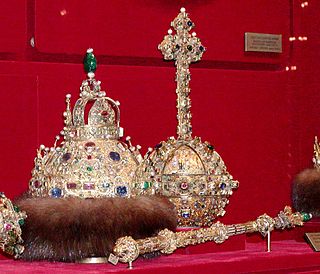






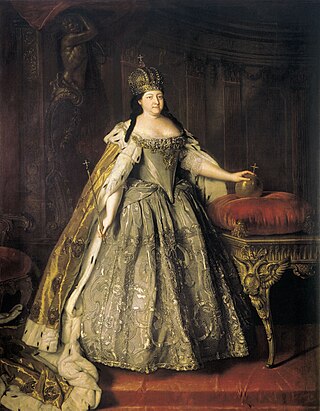




Nessun commento:
Posta un commento